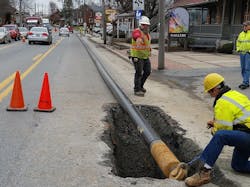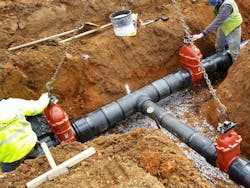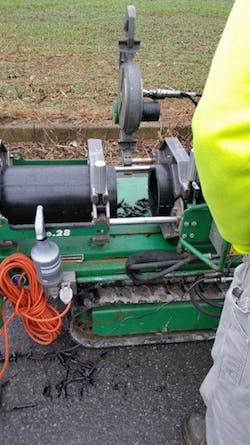About the author:
Steve Cooper is a writer for SCA Communications. Cooper can be reached at [email protected].
The construction of a new potable water pipeline was critical for residents of the bucolic Pennsylvania Amish country because local supply wells were found to have high concentrations of trichloroethylene (TCE), a widely used industrial solvent known to be a human carcinogen. However, the tests did not pinpoint the source and the decision was made to bring water from three new wells that were outside the contaminated area. The $20-million-plus project involved the wells, water tower, a treatment plant and nearly 10 miles of high-density polyethylene (HDPE) pipe to deliver fresh water to nearly 450 homes and businesses. The goal for the new pipeline system was for it to be entirely leak-free.
“About 10 years ago, a developer was building an over-55 housing project and wanted to put in a community water system rather than individual wells for each home,” said David Linahan, principal engineer of Groundwater & Environmental Services Inc. (GES) of Exton, Pa. “This needed a permit, and the state requires much more testing for a community well versus an individual well. The Pennsylvania Department of Environmental Protection (DEP) discovered TCE in the groundwater and wanted to find the source of this contamination. In the meantime, that developer had to put in a treatment system so the water could be approved for drinking purposes. The geology in the community is dolomite, very similar to limestone, and it’s a karst geology that makes it very difficult to predict groundwater movement through the subsurface. That complicated the investigation, and the DEP realized they needed to do something to provide the community with safe drinking water. The department decided to provide a new water supply and distribution system with groundwater wells. Early on, the decision also was made that the distribution piping would be all HDPE with the idea of putting it in using horizontal directional drilling.”
The new system Linahan and his GES team designed would use 52,000 ft of the HDPE pipe plus more than 200 valves and 69 fire hydrants, which were able to be on site within three weeks from the local branches of Core & Main LP, formerly HD Supply Waterworks Ltd., of St. Louis. GES also was responsible for the design and overseeing construction of the 900,000 gal-per-day water treatment plant and the 500,000-gal capacity water tower.
Using the HDPE pipe for the distribution line enabled the system to be installed mostly using horizontal directional drilling (HDD) along Old Philadelphia Pike (PA 340), Newport Road (PA 772), Queen Road, Hatville Road, Field Crest Lane and Harvest Drive, a local township road.
According to a recent Utah State University report, HDPE pipe is commonly used for trenchless applications such as HDD and others.
“HDPE pipe is the number one material for trenchless construction,” said Camille George Rubeiz, P.E., F. ASCE, senior director of engineering, Municipal and Industrial Division for the Plastics Pipe Institute Inc. (PPI). “Its high flexibility, tight bending radius, high impact resistance, high ductility and longest fatigue life makes HDPE the preferred material for the major trenchless installation, such as slip-lining, horizontal directional drilling, Swagelining and pipe bursting.“
Rubeiz said that long continuous segments of HDPE pipe were fused together per ASTM Standards F2620 and F3190. The pipe was then installed with HDD in accordance with ASTM Standard F1962, using PPI Boreaid software and the PPI PE Handbook.
“Also, and per PPIPACE, HDPE provides the largest pipe [inside diameter] and largest [dimension ratio] for water hammer and fatigue conditions,” Rubeiz said. “When compared to open-cut, trenchless significantly minimizes pavement replacement, surface improvement repair, hauling of excavated material, importing backfill material, cost of traffic control and interruption to residents and business. And an HDD installation can typically provide initial cost savings up to 50% over open-cut.”
The HDPE pipe manufactured by WL Plastics of Ft. Worth, Texas; all ancillary components were provided by Core & Main. Both are member companies of PPI and received the Project of the Year Award for the job by the association’s Municipal and Industrial Division. The Projects of the Year is an annual event for PPI, the major North American trade association representing all segments of the plastic pipe industry.
“The use of fusible HDPE pipe along with valves and hydrants that have HDPE fused connections allowed the installers to create one continuous pipeline,” said Tony Radoszewski, CAE, president of PPI. “The new system minimizes and even eliminates the potential for leaks. Plus, HDPE pipe will not corrode or be susceptible to tuberculation, which means better flow and better water quality for generations—some studies even point to a 100-year life. Plastic pipe is ecologically friendly during manufacturing and provides peak protection from contamination during service. Strong, durable, light-weight and flexible, these piping systems require significantly less energy to fabricate, transport and install than metal or iron alternatives. HDPE pipe is tough, ductile and fatigue-resistant, which substantially reduces the chances for waterline failure in the community, decreasing maintenance costs and water interruption for the long term. That is especially important in a pipeline that runs nearly 10 miles.”
To meet the design requirements for HDD and the operating pressure of 60 psi to 80 psi and 150-psi test pressure with a 2,000-gal-per-minute (gpm) fire flow and 125-gpm average flow, the design required PE4710 DR11 IPS per ANSI/AWWA C906.
The shutoff valves were Series 66 gate valves with HDPE fusible ends from American AVK Co. of Minden, Nev., and were installed every 500 ft of the pipe run. Fire hydrants also were heat-fused into the system using an AVK base with polyethylene connectors. Heat-fusing the sections of HDPE pipe, the valves and hydrants provided a monolithic and leak-free system.
Wexcon Inc. of Mohrsville, Pa., was awarded the pipeline construction contract.
“This is a kind of different type of project because they put in the distribution line before the actual wells and treatment tank system,” said John Yoder, vice president, Wexcon. “We had multiple crews with three or four guys in a crew, and we had four crews doing the directional drilling. We had a pullback crew, another connecting drill shots together, another building intersection connections, and another doing water services and hydrants. Standard HDD equipment was used. Maybe 10% of the area had rock, which is typical for southeastern Pennsylvania. In those spots, we had to dig a trench. The longest HDD pull was about an 800-ft drill shot for the 12-in.-diameter HDPE pipe. We had to go through a business parking lot, and they didn’t want any disruption to their business.”
A critical component of the project was to have all the materials—pipe, fittings, valves and fire hydrants—have fusible ends and be delivered to the rural site as needed. There are no mechanical joints that could allow for leakage or any infiltration.
“We were able to offer a complete package to the contractor,” said Chad Smith of Core & Main, who oversaw the project. “We have full-service HDPE centers with not only the ability to fabricate fittings and provide the fusing equipment, but also go on site and have our technicians train the customer how to use that equipment. Our local branch in Etters, Pa., was able to provide service on the fire hydrants, the valves and all the other water service products that go along with the HDPE pipe, while our Poca, W.Va., plant did all the custom fabrication. It was these two branches working together that made this job seamless.”
Core & Main provided a two-day training session for the crew.
“Remember, this was to be a leak-free system using HDPE pipe sections that were fused together, along with valves and hydrants with custom made fittings that were joined to the pipe with electrofusion, so proper training was important,” Smith said.
The installation of distribution piping was completed in 2017 and the treatment plant and tower now are under construction.
“The three drinking water supply wells were installed maybe six years ago. The supply lines from the wells to the treatment plant were also 12-in.-diameter DR11 IPS HDPE pipe,” Linahan said.
The project, including the water treatment plant and water tower, is scheduled for completion in 2020.
About the Author
Steve Cooper
Steve Cooper is a writer for SCA Communications. Cooper can be reached at [email protected].


